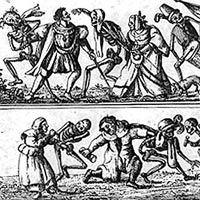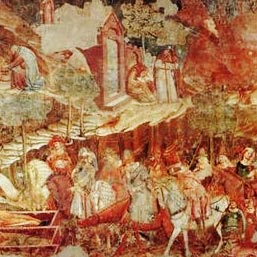Totentanz - The Raging Dance of Death
Franz Liszt's Totentanz is a diabolical concerto for piano and orchestra, filled with dark, dramatic energies.
The piece reflects Liszt's fascination with death and the macabre - the title is German for "Dance of Death"! The piece also showcases Liszt's inventive new ideas about how the piano and orchestra are used and combined.
Liszt incorporates the Dies Irae melody:
...into Totentanz. The melody is an ancient Gregorian chant whose weighty tones inspired many composers, from Berlioz to Rachmaninoff.
First let's see how the piece came into being...
History of the Totentanz

Liszt was inspired by religion, heaven, hell, and death for much of his artistic life.
Whilst in he lived in Paris Liszt visited gallows to observe men condemned to die. These grim expeditions shaped his world view and his musical values.
Liszt started sketching out the piece in the 1830s. In 1839 he went to Pisa in Italy, and saw a fresco: The Triumph of Death. The fourteenth-century painting vividly illustrates the fates of those in heaven and hell. Obviously Liszt was highly moved by it!
But it wasn't until 1849 that he finally created a finished version. Still, it took took more revisions of the piece before the final version was complete (in 1859) - but even then it took another 6 years to finally get performed!
The Totentanz finally got its premiere in 1865 in The Hague, performed by Liszt's son-in-law Hans von Bulow.
Music

The devilish piece features pure Lisztian moments of intense, storm-like fury:
As well as light-hearted, even beautiful passages:
The Dies Irae theme (see above for a soundclip example) originally came from the Mass for the Dead. It's connected with the day of the final judgement, when humanity perishes.
The Dance of Death is actually extremely well-constructed. It features six variations of the Dies Irae melody, each polished and innovative. Balancing the fiery and heavenly, Liszt masterfully controls the orchestra, bringing it into crashing waves of blood-red fury.
The piano part is rough, almost violent in certain sections. For its day this was extremely modern, and bound to have jarred the ears of first-time listeners! Liszt also blends in Medieval counterpoint into the score, whilst still maintaining the piece's modern symphonic sound.
But Liszt doesn't just create a cut-and-dry representation of dark and light. There are loads of thoughtful gray areas, all weaved into the grander fabric of the concerto.
Listen to and explore Mussorgsky's "Night on Bald Mountain", a similarly devilish piece...
Recommended Recordings
Let's look at at a couple of different recordings of the Totentanz...
First up is the recording by legendary Hungarian pianist Georges Cziffra. Cziffra has astonishing technique, which he unleashes on the Dance of Death with raging gusto. Full of delicacy but with explosive anger at times, this is a wonderful version of the piece. Available on the Encore label.
The recording by Jean-Yves Thibaudet is also great in my opinion. Thibaudet really captures all the nuances with his meticulous, sensitive playing.
Thirdly there's the Slavic-flavored recording by pianist Vasily Petrenko. This is a budget version, cleanly played but with little innovation or freshness. The audio is excellent quality though, which is a bonus.
My final recommendation would be the recording by Cziffra. As well as being a fellow Hungarian like Liszt, Cziffra just has the right amount of gleefully devilish energy to tackle the Totentanz in the way it deserves.
You might also be interested in the Dante Symphony, another superb example of Liszt's "evil" music...
If you like my site, please click "Like"... thanks!


